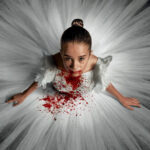“Whispering Shadows”
In the dimly lit corridors of cinematic horror, “Whispering Shadows” emerges as a chilling testament to the enduring allure of the macabre. Directed by acclaimed filmmaker Isabelle Duval, this spine-tingling masterpiece plunges audiences into a realm of darkness and dread, where reality blurs with nightmare and the line between the living and the dead grows ever fainter.

Set against the backdrop of a secluded Victorian mansion shrouded in mist and mystery, “Whispering Shadows” unfolds like a sinister symphony, each discordant note building towards an inexorable crescendo of terror. From the moment the protagonist, Emily, portrayed with haunting intensity by rising starlet Amelia Blackwood, sets foot within its shadowy confines, a sense of unease grips the viewer, tightening like a vice with each passing scene.
Duval’s masterful direction infuses every frame with an atmosphere of palpable dread, leveraging the Gothic architecture of the mansion to evoke a sense of claustrophobia and foreboding. The labyrinthine corridors and decaying chambers serve as a canvas upon which the filmmaker paints a portrait of psychological horror, blurring the boundaries between dream and reality, past and present.

As Emily delves deeper into the mysteries of the mansion, she finds herself ensnared in a web of secrets and lies that stretches back through the ages. Haunted by spectral apparitions and tormented by disembodied whispers, she struggles to discern truth from illusion, her sanity unraveling with each passing moment. Amelia Blackwood delivers a tour-de-force performance, her portrayal of Emily’s descent into madness both harrowing and hypnotic.
Yet, amidst the palpable terror, “Whispering Shadows” offers moments of poignant reflection, exploring themes of guilt, redemption, and the nature of evil. Through a series of chilling revelations, the film peels back the layers of its narrative, exposing the dark heart that beats at the center of the mansion’s history. As Emily confronts the sins of the past, she is forced to confront her own complicity in the unfolding tragedy, grappling with the realization that some secrets are best left buried.
One of the film’s most striking elements is its use of sound design to evoke a sense of dread and disquiet. The titular “whispering shadows” manifest as spectral murmurs that echo through the corridors of the mansion, their origin elusive and their intent malevolent. Composer Gabriel Belmont’s haunting score further heightens the sense of unease, its mournful melodies seeping into the subconscious like a creeping fog.

As the narrative hurtles towards its harrowing climax, “Whispering Shadows” pulls back the veil on the true nature of the mansion’s dark legacy, revealing a twist that will leave audiences reeling. In its final moments, the film poses existential questions that linger long after the credits roll, challenging viewers to confront the darkness that lurks within us all.
In the annals of horror cinema, “Whispering Shadows” stands as a testament to the genre’s enduring power to unsettle and provoke. With its atmospheric visuals, haunting performances, and spine-tingling narrative, it takes its place among the pantheon of classics, a modern masterpiece that will haunt the dreams of viewers long after they have left the theater.

SomeFaq On Whispering Shadows”
Who directed “Whispering Shadows” and what other works are they known for?
Director Isabelle Duval helmed “Whispering Shadows,” known for her distinctive style in crafting atmospheric horror.
2. What inspired the creation of “Whispering Shadows”?
Exploring the genesis of the film offers insights into its themes, narrative choices, and artistic vision.
3. How long did it take to film “Whispering Shadows,” and where was it filmed?
Production details, shooting locations, and any challenges faced during filming shed light on the movie-making process.
4. What was the casting process like for “Whispering Shadows”?
Discovering how the cast was chosen and their approach to embodying their characters adds depth to the film’s performances.
5. What techniques were used to create the eerie atmosphere in “Whispering Shadows”?
Insights into the film’s cinematography, sound design, and visual effects provide a deeper understanding of its chilling ambiance.
6. Are there any hidden Easter eggs or symbolism throughout “Whispering Shadows”?
Unraveling hidden clues or symbolic elements embedded within the film enriches the viewing experience for attentive audiences.
7. How did the filmmakers approach the balance between psychological horror and traditional scares in “Whispering Shadows”?
Exploring the creative decisions behind the film’s scares and psychological tension offers insight into its narrative structure.
8. What was the most challenging scene to film in “Whispering Shadows,” and why?
Learning about the behind-the-scenes challenges and technical difficulties encountered during production adds context to specific scenes.
9. What is the significance of the mansion’s history in “Whispering Shadows”?
Understanding the backstory of the mansion and its connection to the characters elevates the film’s thematic depth.
10. How does “Whispering Shadows” stand out among other horror films released in recent years?
Comparing “Whispering Shadows” to other contemporary horror films highlights its unique storytelling, thematic exploration, and impact on the genre.










